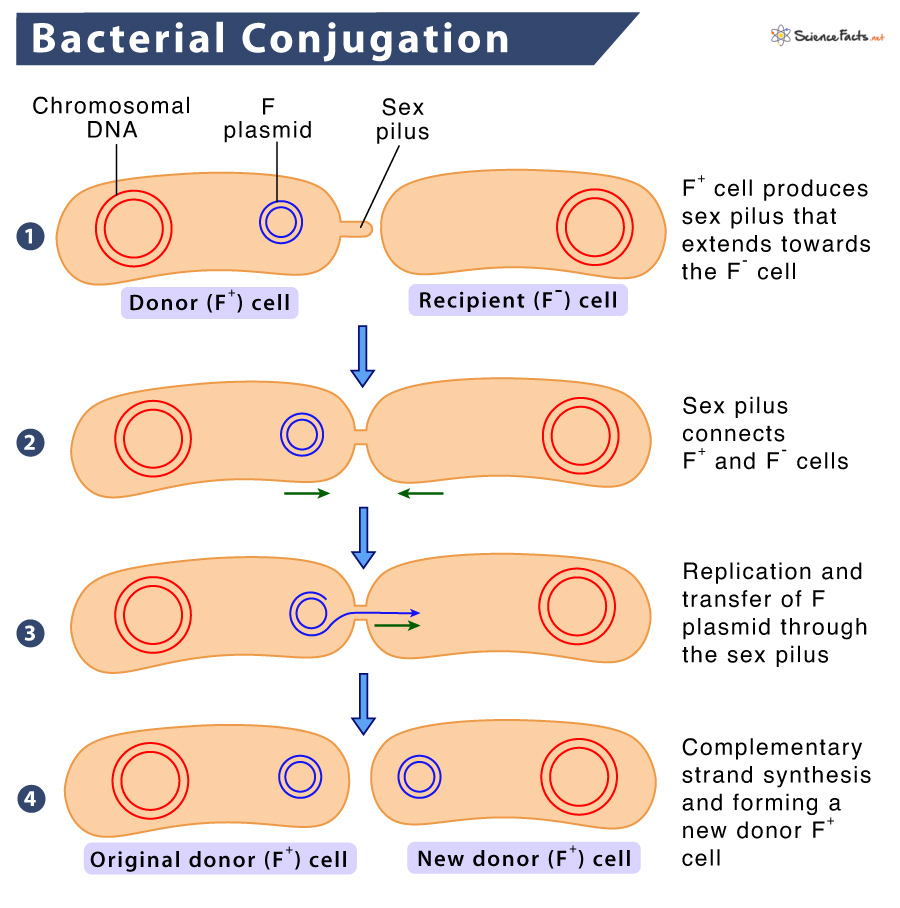Bacterial Conjugation
Conjugation is one of the three primary ways of transferring and exchanging genetic material (DNA) between bacteria. The other two are transduction and transformation. It is a mode of sexual reproduction in bacteria.
Principle
It involves transferring plasmid, other self-transmissible DNA, and sometimes chromosomal DNA from one bacterial cell to the other through direct contact. Thus, one bacterium acts as a donor, and the other serves as the recipient. The plasmid that is transferred is called F-plasmid (F for fertility factor).
Bacterial conjugation was first described by Joshua Lederberg and Edward Tatum in 1946 in bacteria Escherichia coli.
Steps of Bacterial Conjugation
The cell that has a copy of the F- plasmid is called an F- positive, F-plus (F+) cell, or donor cell. In contrast, the cell devoid of a copy of the F- plasmid is called an F-negative, F-minus (F–) cell, or recipient cell. The transfer of F- plasmid takes place through a structure that forms a horizontal connection between the two cells known as sex pilus, F pilus, or conjugation pilus. Donor cell typically acts as a donor because of F-factor, which codes for the proteins that make up the sex pilus. Conjugation is thus an example of horizontal gene transfer.
The four basic steps of bacterial conjugation are given below:
1) Pilus Formation: This is the first step of conjugation. The F+ donor cell produces the sex pilus that extends and begins contact with an F– recipient cell.
2) Establishing Direct Contact between Donor and Recipient: TheF+ cell and the F– cell physically connect, forming a conjugation tube. The pilus helps to draw the two cells closer.
3) Replication and Transfer of F Plasmid: The F plasmid in the F+ cell replicates by a rolling circle mechanism. A copy moves to the recipient. The F- plasmid, a double-stranded DNA molecule, is nicked and opened at its origin of replication site called ori-T.
4) Complementary Strand Synthesis: This is the final conjugation step called the maturation step. Both the donor and the recipient cell contain a single strand of the F plasmid at this stage. The recipient cell ends up forming a double-stranded F plasmid identical to the original donor F plasmid. Thus, the recipient cell now contains a copy of the F plasmid and becomes an F+ donor cell that can make its pilus and transfer DNA to other cells.
Thus, bacterial conjugation allows genes from two different parental cells to come together in the same cell and hence provides an opportunity for genetic recombination.
Types of Bacterial Conjugation
Bacterial conjugation can be of three types.
a) F+ Conjugation (F+ × F– Mating): This is the one described above. It involves the transfer of an F+ plasmid but not chromosomal DNA from a donor cell to a recipient cell.
b) Hfr Conjugation (Hfr+ × F– Mating): Here, an F+ plasmid integrates with the chromosome to become an Hfr+ cell. It then behaves like a donor cell that transfers its Hfr chromosome to the recipient F– cell. The bacterial connection usually breaks before the transfer of the entire chromosome is completed so the rest of the F+ plasmid cannot enter the recipient. Thus, the F– cell remains F– at the end of the transfer.
c) Hfr-F’ Conjugation (Hfr+ × F’ Mating): The F plasmid, being an episome it can leave the bacterial chromosome. Sometimes during this excision, the plasmid makes an error and picks up a portion of the chromosomal DNA to form an F’ plasmid. The newly formed F’ plasmid can now mate with another F’ plasmid. The process is identical to F+ × F– Mating. The recipient becomes F– as the bacterial genes transferred from the F’ cell cannot be incorporated into the recipient chromosome for expression.
Examples of Bacterial Conjugation
- Agrobacterium tumefaciens, the bacteria causing crown gall disease in various plants, transfers its T DNA element (part of the Ti (tumor-inducing), to the plant through conjugation.
- Conjugative plasmids encoding antibiotic-resistance genes are called R plasmids which are transferred through Shigella spp, creating dysentery.
FAQs
Ans. Conjugation involves the direct physical transfer of genetic material from one bacterial cell to another. In contrast, transformation involves the uptake of naked DNA by bacteria from its environment.
Ans. Conjugation involves the direct physical transfer of genetic material from one bacterial cell to another. In contrast, transduction involves the transfer of genetic material from one bacterial cell to another by a bacteriophage.
-
References
Article was last reviewed on Wednesday, February 1, 2023




